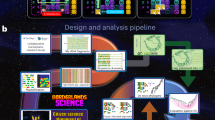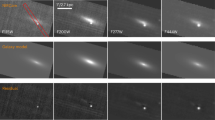Abstract
Observational work conducted over the past few decades indicates that all massive galaxies have supermassive black holes at their centres. Although the luminosities and brightness fluctuations of quasars in the early Universe suggest that some were powered by black holes with masses greater than 10 billion solar masses1,2, the remnants of these objects have not been found in the nearby Universe. The giant elliptical galaxy Messier 87 hosts the hitherto most massive known black hole, which has a mass of 6.3 billion solar masses3,4. Here we report that NGC 3842, the brightest galaxy in a cluster at a distance from Earth of 98 megaparsecs, has a central black hole with a mass of 9.7 billion solar masses, and that a black hole of comparable or greater mass is present in NGC 4889, the brightest galaxy in the Coma cluster (at a distance of 103 megaparsecs). These two black holes are significantly more massive than predicted by linearly extrapolating the widely used correlations between black-hole mass and the stellar velocity dispersion or bulge luminosity of the host galaxy5,6,7,8,9. Although these correlations remain useful for predicting black-hole masses in less massive elliptical galaxies, our measurements suggest that different evolutionary processes influence the growth of the largest galaxies and their black holes.
This is a preview of subscription content, access via your institution
Access options
Subscribe to this journal
Receive 51 print issues and online access
$199.00 per year
only $3.90 per issue
Buy this article
- Purchase on Springer Link
- Instant access to full article PDF
Prices may be subject to local taxes which are calculated during checkout



Similar content being viewed by others
References
Netzer, H. The largest black holes and the most luminous galaxies. Astrophys. J. 583, L5–L8 (2003)
Vestergaard, H., Fan, X., Tremonti, C. A., Osmer, P. S. & Richards, G. T. Mass functions of the active black holes in distant quasars from the Sloan Digital Sky Survey data release 3. Astrophys. J. 674, L1–L4 (2008)
Sargent, W. L. W. et al. Dynamical evidence for a central mass concentration in the galaxy M87. Astrophys. J. 221, 731–744 (1978)
Gebhardt, K. et al. The black hole mass in M87 from Gemini/NIFS adaptive optics observations. Astrophys. J. 729, 119 (2011)
Dressler, A. in Active Galactic Nuclei (eds Osterbrock, D. E. & Miller, J. S. ) 217–232 (IAU Symposium 134, Springer, 1989)
Kormendy, J. & Richstone, D. Inward bound the search for supermassive black holes in galactic nuclei. Annu. Rev. Astron. Astrophys. 33, 581–624 (1995)
Ferrarese, L. & Merritt, D. A fundamental relation between supermassive black holes and their host galaxies. Astrophys. J. 539, L9–L12 (2000)
Gebhardt, K. et al. A relationship between nuclear black hole mass and galaxy velocity dispersion. Astrophys. J. 539, L13–L16 (2000)
Gültekin, K. et al. The MBH−σ and MBH−L relations in galactic bulges, and determinations of their intrinsic scatter. Astrophys. J. 698, 198–221 (2009)
Laine, S. et al. Hubble Space Telescope imaging of brightest cluster galaxies. Astron. J. 125, 478–505 (2003)
Postman, M. & Lauer, T. R. Brightest cluster galaxies as standard candles. Astrophys. J. 440, 28–47 (1995)
Schwarzschild, M. A numerical model for a triaxial stellar system in dynamical equilibrium. Astrophys. J. 232, 236–247 (1979)
Loubser, S. I., Sansom, A. E., Sánchez-Blázquez, P., Soechting, I. K. & Bromage, G. E. Radial kinematics of brightest cluster galaxies. Mon. Not. R. Astron. Soc. 391, 1009–1028 (2008)
Lauer, T. R. et al. The masses of nuclear black holes in luminous elliptical galaxies and implications for the space density of the most massive black holes. Astrophys. J. 662, 808–834 (2007)
Dalla Bontà, E. et al. The high-mass end of the black hole mass function: mass estimates in brightest cluster galaxies. Astrophys. J. 690, 537–559 (2009)
McConnell, N. J. et al. The black hole mass in brightest cluster galaxy NGC 6086. Astrophys. J. 728, 100 (2011)
Nowak, N. et al. The supermassive black hole of Fornax A. Mon. Not. R. Astron. Soc. 391, 1629–1649 (2008)
Di Matteo, T., Volker, S. & Hernquist, L. Energy input from quasars regulates the growth and activity of black holes and their host galaxies. Nature 433, 604–607 (2005)
Robertson, B. et al. The evolution of the MBH − σ relation. Astrophys. J. 641, 90–102 (2006)
Boylan-Kolchin, M., Ma, C.-P. & Quataert, E. Red mergers and the assembly of massive elliptical galaxies: the fundamental plane and its projections. Mon. Not. R. Astron. Soc. 369, 1081–1089 (2006)
Hopkins, P. F., Bundy, K., Hernquist, L. & Ellis, R. S. Observational evidence for the coevolution of galaxy mergers, quasars, and the blue/red galaxy transition. Astrophys. J. 659, 976–996 (2007)
Lauer, T. R., Tremaine, S., Richstone, D. & Faber, S. M. Selection bias in observing the cosmological evolution of the MBH−σ and MBH−L relationships. Astrophys. J. 670, 249–260 (2007)
Allington-Smith, J. et al. Integral field spectroscopy with the Gemini Multi-Object Spectrograph. I. Design, construction, and testing. Publ. Astron. Soc. Pacif. 114, 892–912 (2002)
Hill, G. J. et al. Design, construction, and performance of VIRUS-P: the prototype of a highly replicated integral field spectrograph for the HET. Proc. Soc. Photo-opt. Instrum. Eng. 7014, 701470 (2008)
Larkin, J. et al. OSIRIS: a diffraction limited integral field spectrograph for Keck. Proc. Soc. Photo-opt. Instrum. Eng. 6269, 62691A (2006)
Acknowledgements
N.J.M., C.-P.M, K.G. and J.R.G. are supported by the National Science Foundation. C.-P.M. is supported by NASA and by the Miller Institute for Basic Research in Science, University of California, Berkeley. S.A.W. is supported by NASA through a Hubble Fellowship. Data presented here were obtained using the Gemini Observatory, the W. M. Keck Observatory and the McDonald Observatory. The Gemini Observatory is operated by the Association of Universities for Research in Astronomy, Inc., under a cooperative agreement with the National Science Foundation on behalf of the Gemini partnership. The W. M. Keck Observatory is operated as a scientific partnership among the California Institute of Technology, the University of California and NASA. The McDonald Observatory is operated by the University of Texas at Austin. The instrument VIRUS-P was funded by G. and C. Mitchell. Stellar orbit models were run using the facilities at the Texas Advanced Computing Center at The University of Texas at Austin.
Author information
Authors and Affiliations
Contributions
N.J.M. carried out the data analysis and modelling. N.J.M, C.-P.M. and S.A.W. wrote the manuscript. C.-P.M. compiled the data for Fig. 3 and oversaw communication among co-authors. S.A.W. analysed OSIRIS data on NGC 3842. K.G. provided GMOS data on NGC 3842 and NGC 4889. K.G. and D.O.R. developed the stellar orbit modelling code. J.D.M. provided VIRUS-P data on NGC 3842. T.R.L. provided photometric data on and image analysis of NGC 3842 and NGC 4889. J.R.G. led the OSIRIS observing campaign for NGC 3842. All authors contributed to the interpretive analysis of the observations and the writing of the paper.
Corresponding authors
Ethics declarations
Competing interests
The authors declare no competing financial interests.
Supplementary information
Supplementary Information
This file contains Supplementary Text and Data, Supplementary Figures 1-7 with legends and additional references. (PDF 435 kb)
Supplementary Data
This file contains data for the line-of-sight velocity distributions at various spatial locations in the central regions of galaxies NGC 3842 and NGC 4889. (TXT 81 kb)
Rights and permissions
About this article
Cite this article
McConnell, N., Ma, CP., Gebhardt, K. et al. Two ten-billion-solar-mass black holes at the centres of giant elliptical galaxies. Nature 480, 215–218 (2011). https://doi.org/10.1038/nature10636
Received:
Accepted:
Issue Date:
DOI: https://doi.org/10.1038/nature10636
This article is cited by
-
Primordial black hole mass functions as a probe of cosmic origin
Science China Physics, Mechanics & Astronomy (2024)
-
A new model of quasar mass evolution
Astrophysics and Space Science (2022)
-
Distinguishing Tidal Disruption Events from Impostors
Space Science Reviews (2021)
-
No tension between assembly models of super massive black hole binaries and pulsar observations
Nature Communications (2018)
-
A 17-billion-solar-mass black hole in a group galaxy with a diffuse core
Nature (2016)
Comments
By submitting a comment you agree to abide by our Terms and Community Guidelines. If you find something abusive or that does not comply with our terms or guidelines please flag it as inappropriate.



